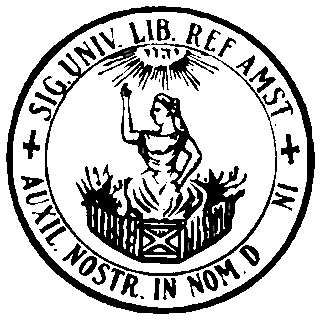
The Vrije Universiteit Amsterdam is a public research university in Amsterdam, Netherlands, being founded in 1880. The VU Amsterdam is one of two large, publicly funded research universities in the city, the other being the University of Amsterdam (UvA). The literal translation of the Dutch name Vrije Universiteit is "Free University". "Free" refers to independence of the university from both the State and the Dutch Reformed Church. Both within and outside the university, the institution is commonly referred to as "the VU". Although founded as a private institution, the VU has received government funding on a parity basis with public universities since 1970. The university is located on a compact urban campus in the southern Buitenveldert neighbourhood of Amsterdam and adjacent to the modern Zuidas business district.

The Diocese of Haarlem–Amsterdam is a Latin diocese of the Catholic Church in the Netherlands. As one of the seven suffragans in the ecclesiastical province of the Metropolitan Archbishop of Utrecht, the diocesan territory comprises the north west of the Netherlands, including the cities of Haarlem and Amsterdam.
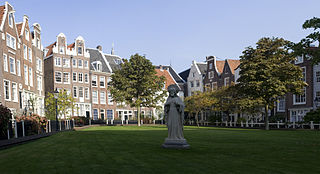
The Begijnhof is one of the oldest hofjes in Amsterdam, Netherlands. A group of historic buildings, mostly private dwellings, centre on it. As the name suggests, it was originally a béguinage. Today it is also the site of two churches, the Catholic Houten Huys and the English Reformed Church.
Dominie is a Scots language and Scottish English term for a Scottish schoolmaster usually of the Church of Scotland and also a term used in the US for a minister or pastor of the Dutch Reformed Church.

The Singel is one of the canals of Amsterdam. The Singel encircled Amsterdam in the Middle Ages, serving as a moat around the city until 1585, when Amsterdam expanded beyond the Singel. The canal runs from the IJ bay, near the Central Station, to the Muntplein square, where it meets the Amstel river. It is now the inner-most canal in Amsterdam's semicircular ring of canals.

The Jodenbreestraat is a street in the centre of Amsterdam, which connects the Sint Antoniesluis sluice gates to the Mr. Visserplein traffic circle. North of the sluice gates, the street continues on to Nieuwmarkt square as the Sint Antoniesbreestraat. The Mozes en Aäronkerk church stands at the southern end of the street. Directly behind the Jodenbreestraat is Waterlooplein square with its daily flea market.

The Noorderkerk is a 17th-century Protestant church in Amsterdam, The Netherlands. The Noorderkerk is located along Prinsengracht canal, on Noordermarkt square. The church is used for Dutch Reformed Church services and is also used regularly for classical music concerts.

The Oosterkerk is a 17th-Century Dutch Reformed church in Amsterdam, The Netherlands.
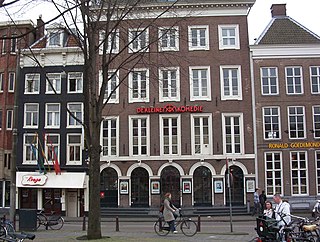
De Kleine Komedie is today the oldest theatre in Amsterdam, dating from 1788. Situated on the Amstel near the Halvemaansteeg, the building offers a stage for both upcoming and established Dutch talents. The theatre has 503 seats.
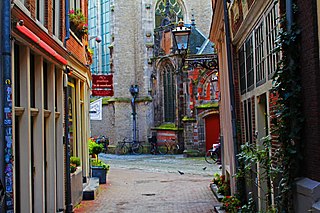
The Prostitution Information Centre is located in the heart of Amsterdam in the red light district, near Amsterdam's Old Church. The PIC serves as an educational centre and resource for providing Amsterdam's visitors with information and advice about prostitution.

Nieuwezijds Kapel, or Heilige Stede or Chapel of the Heilige Stede refers to a site in Amsterdam that includes shops and a Dutch Reformed church built in 1908 on the site of a church once called the Heilige Stede, originally built in the 15th century to replace a chapel that burned in a city fire of 1452. That original chapel had been built in 1347 as a result of the miracle of Amsterdam, located on the Kalverstraat where this miracle with the eucharistic host occurred.

Ons' Lieve Heer op Solder is a 17th-century canal house, house church, and museum in the city center of Amsterdam, The Netherlands. The Catholic Church was built on the top three floors of the canal house during the 1660s. It is an important example of a "schuilkerk", or "clandestine church" in which Catholics and other religious dissenters from the seventeenth century Dutch Reformed Church, unable to worship in public, held services. The church has been open as a museum since 28 April 1888, and has 85,000 visitors annually.

The Amstelhof, was a retirement home that is the H'ART Museum. It was built near the Amstel river in 1682 by the diaconate of the Dutch Reformed Church after having received an inheritance of the rich merchant Barent Helleman. He died on 18 October 1680 and left approximately 90,000 guilders to the church. The city of Amsterdam donated the land on which it was built.
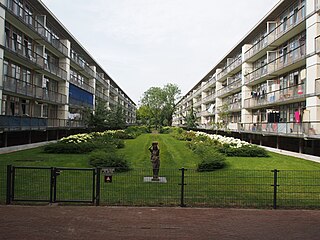
Bos en Lommer is a neighborhood of Amsterdam, Netherlands. From 1990 to 2010 it was considered a district of the municipality of Amsterdam in the province of North Holland. As of May 1, 2010, it was merged into the new Amsterdam-West borough.
The Jodenbuurt is a neighbourhood of Amsterdam, Netherlands. For centuries before World War II, it was the center of the Dutch Jews of Amsterdam — hence, its name. It is best known as the birthplace of Baruch Spinoza, the home of Rembrandt, and the Jewish ghetto of Nazi occupation of the Netherlands.

Oostelijke Eilanden, also known as Oostelijke Eilanden en Kadijken, is a neighbourhood in the centre of Amsterdam, Netherlands, consisting of Kattenburg, Wittenburg and Oostenburg.

The Scots International Church or the Scottish Church is located in Rotterdam, The Netherlands. An English-language Protestant church in the Presbyterian tradition, it is part of the Church of Scotland, within the Church's Presbytery of Europe.

The equestrian statue of Queen Wilhelmina in Amsterdam is located on Rokin street, at the corner with Langebrugsteeg alley. The statue of Queen Wilhelmina of the Netherlands was sculpted in bronze by Theresia R. van der Pant.
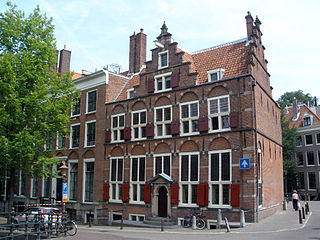
The Huis aan de Drie Grachten or Huis op de Drie Grachten is a 17th-century canal house in Amsterdam, at the southeastern end of the Wallen district. The name is a reference to the fact that the building faces three different Amsterdam canals. The south facade faces Grimburgwal, the west facade faces Oudezijds Voorburgwal and the east facade faces Oudezijds Achterburgwal. The address is Oudezijds Voorburgwal 249.
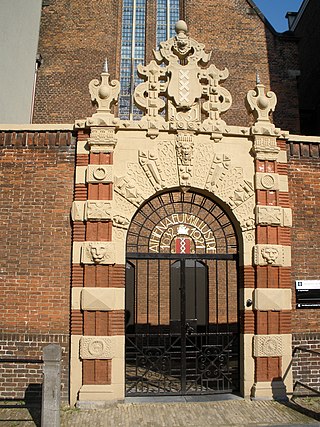
Athenaeum Illustre, or Amsterdamse Atheneum, was a city-sponsored 'illustrious school' founded after the beeldenstorm in the old Agnieten chapel on the Oudezijds Voorburgwal 231 in Amsterdam, Netherlands. Famous scientists such as Caspar Barlaeus, Gerardus Vossius, Martinus Hortensius, Alexander de Bie, and Petrus Camper taught here.




















